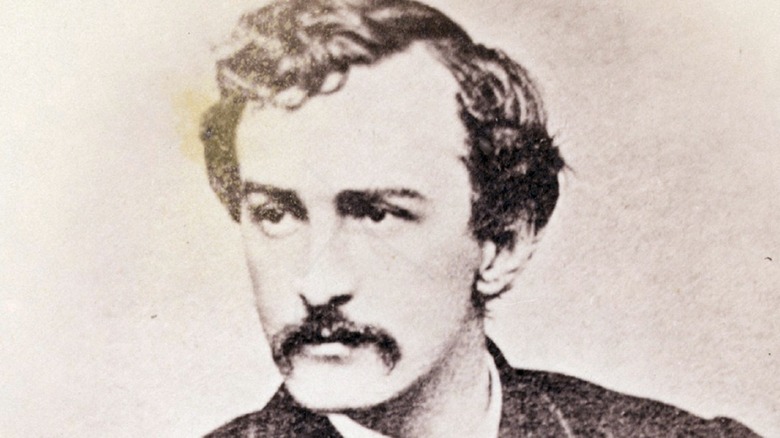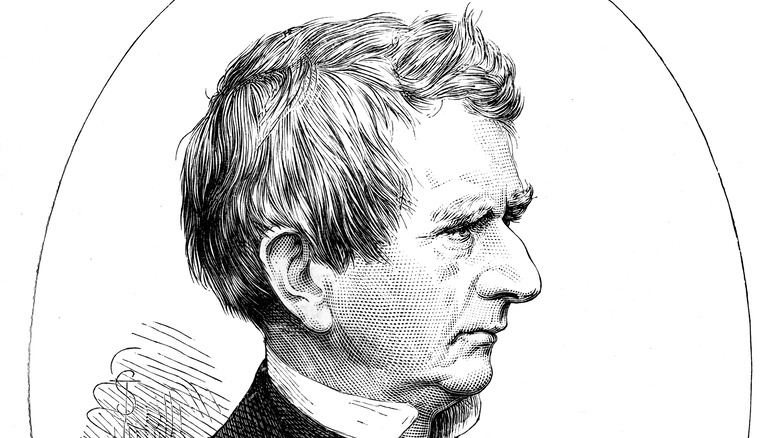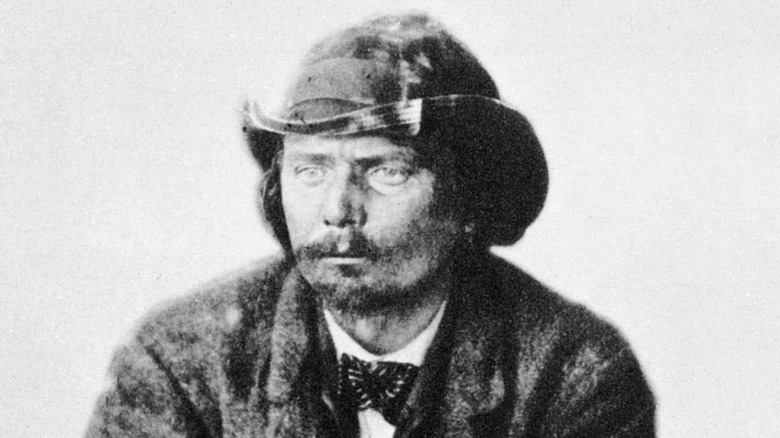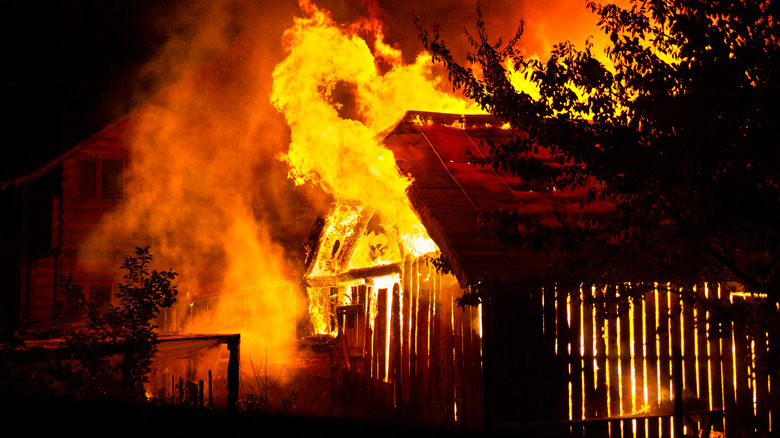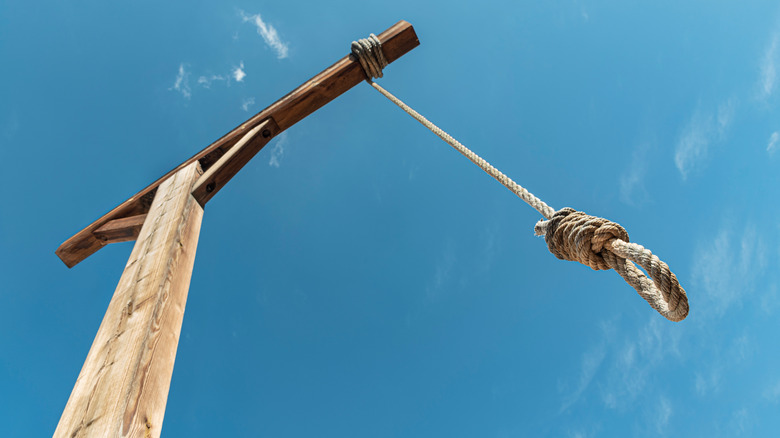The Truth About The Manhunt For John Wilkes Booth
On the evening of April 14, 1865, President Abraham Lincoln and first lady Mary Todd Lincoln were attending a play with another couple. Major Henry Rathbone and his fiance Clara Harris joined the Lincolns at Ford's Theater in D.C. to enjoy the production of "Our American Cousin." What began as a normal evening out ended in a national tragedy, which soon after fomented one of the most extensive manhunts in the history of the United States.
In the middle of the production, assassin John Wilkes Booth (above) crept into the box where the president and his party were seated. Firing a shot six inches from Lincoln's head, Booth then sliced at Rathbone's arm before leaping out of the box and onto the stage to make his escape (via Library of Congress), breaking his leg in the process. Still alive, but unconscious, Lincoln was carried across the street to Peterson House for immediate medical care. Following his death early the next morning, Abraham Lincoln became the first president in United States history to be assassinated.
The events that unfolded in the following 12 days involved uncovering a grand plot aimed at multiple political assassinations, a drunk co-conspirator, and a fiery conclusion at the end of the manhunt.
Lincoln wasn't the only target
On the night of Lincoln's shooting, Secretary of State William Seward (above) was home in bed, ill. A servant of Seward's answered an evening knock at the door by Lewis Powell, who claimed to be delivering medicine to the ailing government official (via CBS). After being denied entry, the visitor charged through the front door. His path blocked by one of Seward's sons, the intruder brandished a revolver and tried to fire it. It misfired, so he hit Seward's son with it instead.
Now brandishing a knife, the intruder made his way to the senior Seward's room. He managed to stab him twice, before being himself attacked by Seward's other son and a bodyguard. In a panic, the would-be assassin managed to stab or strike eight people. Fortunately, all survived their injuries (via CBS).
While Powell managed to escape, he was later apprehended at a boarding house owned by Mary Surratt. Federal agents were at Surratt's boarding house questioning her about Booth, whom officials knew she was well acquainted with. Powell, hurt and in blood-soaked clothing, was placed under arrest (via CBS).
When word of Seward's attack reached Secretary of War Edwin Stanton, Stanton feared there was a massive attack on high-ranking government officials. He ordered the city locked down, and sent hundreds of federal agents to various positions around the nation's capitol (via History Collection). Meanwhile, Vice President Andrew Johnson slept quietly in his room at Kirkwood House. Another would-be assassin was preparing to kill him in his sleep.
Alcohol derails part of the plot
George Atzerodt (above) had a single job to do on April 14, 1865. He was to wait until Andrew Johnson was asleep, and then enter his quarters and shoot him. His orders seemed simple enough. Unfortunately for those who trusted Atzerodt, this particular hired gun was an alcoholic (via History Collection). Atzerodt got drunk in the hotel bar at Kirkwood house. Even though he had a room booked at that very hotel, he staggered across the street to another hotel, where he passed out. En route, he discarded a vicious-looking knife. A witness, alarmed, alerted police of Atzerodt's suspicious behavior.
Police arrived later at the hotel, and searched the room Atzerodt's room at Kirkwood House. There, they found a bank book belonging to John Wilkes Booth. Not able to immediately locate Atzerodt, officials got a break several days later. He was arrested at the home of a relative on April 20, 1865 (via History Collection). Atzerodt turned out to be pretty cooperative, and was helpful in deciphering the complicated plot that unraveled the evening that Lincoln was shot.
Booth, meanwhile, had met at a pre-determined rendezvous point with co-conspirator David Herold. Herold had been appointed a lookout for Lewis Powell, but had panicked and fled the scene of the botched Seward assassination attempt. Booth was now unaware of the whereabouts of both Powell and Atzerodt, but knew he was on borrowed time. He and Herold quickly fled (via History Collection).
How Booth was almost burned to death
The manhunt was on. Agents knew that Booth had broken his leg, and was traveling with a male co-conspirator. Fleeing through Maryland and into Virginia, Booth and Herold took refuge in an old tobacco barn (via CBS). The barn was on a farm owned by the Garrett family, who took sympathy on the two strangers who arrived on April 24, 1865. The two men they fed and sheltered told their hosts that they were Confederate soldiers, and were passing through the area to go home (via History Collection).
Federal agents were able to locate Booth and Herold on the evening of April 25, 1865. The agents demanded Booth and Herold surrender, which Booth outright refused. A standoff began, but after a time stuck in the barn, Booth requested that Herold be let free. Booth himself refused to exit. Under orders of the commanding officer, Everton Conger, the barn was set on fire. Still, Booth refused to leave (via History Collection).
The spaces in the barn walls made Booth, who could be seen pacing back and forth in the growing inferno, an easy target. The troops were under orders not to fire, but Sergeant Boston Corbett fired anyway (via History Collection). His shot hit and crippled Booth. The troops removed the wounded Booth from the barn and took him to the family's front porch, where he died a few hours later.
Eight conspirators convicted
A total of seven men and one woman were put on trial for the conspiracy surrounding the assassination of President Abraham Lincoln. They were tried by a military tribunal, rather than a civil trial, under the reasoning that Washington D.C. was under martial law when the crimes took place. The tribunal consisted of nine Army officers.
Four were sentenced to hang from the gallows. The four who met their fate at the end of the noose were Mary Surratt, David Herold, Lewis Powell, and George Atzerodt (via Civil War on the Western Border). They were executed July 7, 1865. Surratt has the sorrowful distinction of being the first woman executed by the federal government (via History Collection). The remaining four defendants were sentenced to life in prison. Only one of the four co-conspirators, Dr. Samuel Mudd, was released from prison. He was granted a pardon by President Johnson in 1869 (via Famous Trials). Mudd died from pneumonia in 1883.
